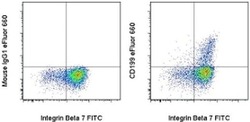Antibody data
- Antibody Data
- Antigen structure
- References [4]
- Comments [0]
- Validations
- Flow cytometry [1]
Submit
Validation data
Reference
Comment
Report error
- Product number
- 50-1999-42 - Provider product page

- Provider
- Invitrogen Antibodies
- Product name
- CD199 (CCR9) Monoclonal Antibody (BBC3M4), eFluor™ 660, eBioscience™
- Antibody type
- Monoclonal
- Antigen
- Other
- Description
- Description: This BBC3M4 monoclonal antibody reacts with human CD199 (CCR9), a 7 transmembrane spanning G-protein-coupled receptor. CCR9 expression is regulated during thymic development and CCR9 deficiency results in mild impairment in thymocyte development. In the periphery, CCR9 and alpha 4 beta 7 integrin are upregulated in response to dendritic cell-derived retinoic acid, conferring preferential trafficking to gut-associated tissues. CCR9 is the receptor for CCL25 (TECK). Applications Reported: This BBC3M4 antibody has been reported for use in flow cytometric analysis. Applications Tested: This BBC3M4 antibody has been pre-titrated and tested by flow cytometric analysis of stimulated normal human peripheral blood cells. This can be used at 5 µL (0.25 µg) per test. A test is defined as the amount (µg) of antibody that will stain a cell sample in a final volume of 100 µL. Cell number should be determined empirically but can range from 10^5 to 10^8 cells/test. eFluor® 660 is a replacement for Alexa Fluor® 647. eFluor® 660 emits at 659 nm and is excited with the red laser (633 nm). Please make sure that your instrument is capable of detecting this fluorochome. Excitation: 633-647 nm; Emission: 668 nm; Laser: Red Laser. Filtration: 0.2 µm post-manufacturing filtered.
- Reactivity
- Human
- Host
- Mouse
- Isotype
- IgG
- Antibody clone number
- BBC3M4
- Vial size
- 100 Tests
- Concentration
- 5 µL/Test
- Storage
- 4° C, store in dark, DO NOT FREEZE!
Submitted references Retinoic acid-induced CCR9 expression requires transient TCR stimulation and cooperativity between NFATc2 and the retinoic acid receptor/retinoid X receptor complex.
Efficient induction of CCR9 on T cells requires coactivation of retinoic acid receptors and retinoid X receptors (RXRs): exaggerated T Cell homing to the intestine by RXR activation with organotins.
Retinoic acid imprints gut-homing specificity on T cells.
TECK, an efficacious chemoattractant for human thymocytes, uses GPR-9-6/CCR9 as a specific receptor.
Ohoka Y, Yokota A, Takeuchi H, Maeda N, Iwata M
Journal of immunology (Baltimore, Md. : 1950) 2011 Jan 15;186(2):733-44
Journal of immunology (Baltimore, Md. : 1950) 2011 Jan 15;186(2):733-44
Efficient induction of CCR9 on T cells requires coactivation of retinoic acid receptors and retinoid X receptors (RXRs): exaggerated T Cell homing to the intestine by RXR activation with organotins.
Takeuchi H, Yokota A, Ohoka Y, Kagechika H, Kato C, Song SY, Iwata M
Journal of immunology (Baltimore, Md. : 1950) 2010 Nov 1;185(9):5289-99
Journal of immunology (Baltimore, Md. : 1950) 2010 Nov 1;185(9):5289-99
Retinoic acid imprints gut-homing specificity on T cells.
Iwata M, Hirakiyama A, Eshima Y, Kagechika H, Kato C, Song SY
Immunity 2004 Oct;21(4):527-38
Immunity 2004 Oct;21(4):527-38
TECK, an efficacious chemoattractant for human thymocytes, uses GPR-9-6/CCR9 as a specific receptor.
Youn BS, Kim CH, Smith FO, Broxmeyer HE
Blood 1999 Oct 1;94(7):2533-6
Blood 1999 Oct 1;94(7):2533-6
No comments: Submit comment
Supportive validation
- Submitted by
- Invitrogen Antibodies (provider)
- Main image

- Experimental details
- CD4+ T cells isolated from normal human perpheral blood cells were stimulated for 3 days with all-trans retinoic acid, Anti-Human CD3, and Anti-Human CD28 Functional Grade Purifieds (Product # 16-0037-81 and Product # 16-0289-81). The cells were cultured for 2 additional days with all-trans retinoic acid and Human IL-2 Recombinant Protein (Product # 14-8029-81). These cells were surface stained with Anti-Human/Mouse Integrin beta 7 FITC (Product # 11-5867-42) and Mouse IgG1 K Isotype Control eFluor® 660 (Product # 50-4714-82) (left) or Anti-Human CD199 (CCR9) eFluor® 660 (right). Total viable cells were used for analysis.
 Explore
Explore Validate
Validate Learn
Learn Flow cytometry
Flow cytometry